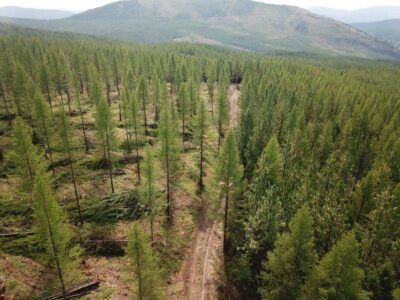Digitalization and Predictive Policing in Conservation
Does technology shift focus toward “green policing” and away from integrated conservation and development?
Digitalization is reshaping environmental governance in profound ways. As environmental degradation and climate change intensify, society increasingly turns to digital technologies to live more sustainably and protect biodiversity and other natural resources, such as land, water, and energy. Digital tools are transforming who is involved in environmental decision-making, how environmental problems are understood and assessed, and what actions are ultimately taken. To explore the intersection of digitalization and environmental governance and the power dynamics that are at play, I interviewed three social scientists on the matter. The work culminated in three audio interviews with these experts and a summary article for each interview. The project can be found here and the first article is below.
—
This article provides an overview of the first interview in a three-part interview series that explores how digitalization is reshaping environmental governance. I spoke with James Stinson, a postdoctoral fellow in planetary health and education at both the Dadahleh Institute for Global Health Research and the Faculty of Education at York University in Toronto, Ontario. Stinson is a cultural anthropologist who studies digitalization, datafication, and automation within conservation, with a special focus on digital surveillance and smart technologies.
His current research project undertakes a qualitative and ethnographic examination of the Spatial Monitoring and Reporting Tool (SMART) and how it’s being implemented in Belize. SMART is a digital platform for data collection, storage, and analysis within conservation. It streamlines and simplifies the work of park rangers and allows protected area managers to combine ranger data with satellite and drone imagery, acoustic sensor data, trail camera footage, etc., to produce real-time analyses, management plans, and reports for funders.
Through his fieldwork — which includes participant observation and interviews with rangers, protected area managers, conservation organizations, and funders — Stinson investigates how digital platforms and the data they produce change relations of power between conservation actors. He’s interested in how surveillance technologies like SMART standardize approaches to conservation and promote the criminalization and policing of communities, in contrast to more development-oriented approaches.
SMART was developed around 2011 by a range of international conservation organizations, including the World Wildlife Fund, Peace Parks Foundation, and the Wildlife Conservation Society. It has quickly emerged as a global standard for park and protected area management and has been adopted in over seventy countries and over a thousand protected areas worldwide. It became the official monitoring system for terrestrial and marine protected areas in Belize in 2018.
SMART increases transparency and opens “lines of visibility” between conservation actors, Stinson explains. “SMART is often promoted and thought about as a tool to monitor and manage biodiversity.” However, he adds, “it’s possible for us to think about SMART as a worker management and surveillance tool as well, because SMART ultimately makes the activities of rangers much more visible to their direct supervisors.” Stinson elaborates further, arguing that SMART makes the work of conservation organizations more visible to their funders. Funding organizations want to know whether or not their money is being spent efficiently and effectively. With SMART, conservation managers can now tell funders the number of patrols that have been deployed, the number of illegal activities that were observed, the amount of fuel that was consumed by patrols, the number of ranger hours that were spent on patrol, etc. Stinson believes that this increased visibility is why funding organizations are such strong advocates of SMART. The inverse is also true: conservation organizations recognize that using SMART will help them attract more funding.
The Belizean government is another strong proponent of SMART, Stinson claims. He reports that the government is looking to create a real-time database or dashboard for conservation that would ultimately be fed by tools like SMART. Similar to conservation organizations, the government recognizes that the data produced by digital tools is highly prized by potential funders. “We’ve emerged into an economy where data is the primary raw material that has value,” Stinson argues. He notes the growing struggles between conservation actors over the data that’s being generated, because of how the control of data shapes funding decisions.
The digital shift within conservation has been driven by new actors in Big Tech, in addition to more traditional actors. Stinson sees companies like Microsoft, IBM, and Google funneling large amounts of money into conservation to develop technical solutions to biodiversity loss, climate change, and species extinction. These companies have a “financial interest in promoting the digitalization of environments and generating data that can be incorporated into new economies of data surveillance,” he explains. The data these companies collect can be used to train their AI-powered commercial products. The involvement of Big Tech — as well as governmental and non-governmental actors — raises complex questions and concerns about data access, security, and control.
While digital platforms like SMART are producing new relationships, dependences, and power dynamics between conservation actors, digitalization is also reshaping what conservation means and how it’s practiced in Belize. In the 1990s, Belize began building an expansive system of protected areas. As a result, thirty to thirty-five percent of the country is now under protected area status. The Belizean government lacked the capacity and resources to manage all these protected areas and therefore devolved the management responsibilities to non-governmental organizations and community groups. What formed was a patchwork of organizations — all with their own skills, capacities, strategies, and priorities — managing the protected areas of Belize. While this makes conservation within Belize special and unique, some view it as counterproductive. Stinson argues that one of the goals of SMART has been to standardize approaches to biodiversity management across organizations, in order to facilitate the more efficient sharing of information.
He feels that the standardization of approaches to conservation and protected area management within Belize has drawbacks. “As a cultural anthropologist, I’m trained to recognize the value in cultural diversity and approaches…and SMART, in some ways, is not in line with that,” he argues. Stinson is interested in exploring how these digital tools can support and advance different knowledge systems and worldviews, not constrain them. He observes that the more uniform, standardized approach to conservation in Belize, embodied by SMART, has unfortunately led to the devaluing of local knowledge systems.
One strategy for involving communities directly in protected area management has been through forms of what Stinson calls, “intimate governance.” This is an approach that “operationalize[s] social connections…and lines of visibility and power within a community, in order to promote conservation.” In theory, community members monitor, influence, and exert social pressure on one another in order to discourage anti-social and anti-environmental behavior. The risk of being spotted and reprimanded by a fellow member of the community is meant to act as a deterrent to illegal activities. With intimate governance, the monitoring by community members can be partial in its coverage, but must be conspicuous and understood by all within the community.
Stinson worries that SMART represents a shift away from intimate governance and toward a model of “green policing” or “conservation policing.” With these latter approaches, the focus is on using big data, artificial intelligence, monitoring, and surveillance technologies to prevent illegal activities inside parks and protected areas. In contrast to intimate governance, these technologies are designed to be invisible and undetectable by members of a community and complete in their coverage. Stinson argues that the assemblage of digital technologies, such as cameras, drones, and satellites, creates “new surveillance environments.” And whereas intimate governance uses informal surveillance by community members as a deterrent, digital tools like SMART use surveillance to criminalize people and facilitate real-time intervention.
This trend in “green policing” is a strong analog to fortress conservation — a problematic, centuries-old, approach to conservation. Stinson traces fortress conservation to the late 1800s, when the global movement to create parks and protected areas first began. It was about “creating parks and protected areas that had pretty restricted borders and the emphasis was on policing and trying to eliminate human activity within those parks and protected areas,” he explains.
According to Stinson, in the 1990s and early 2000s there was a shift away from fortress conservation. A new model of conservation — integrated conservation and development — was popularized. The goal was to involve people in conservation and provide economic and social benefits to communities. “Belize was really at the forefront of that movement,” Stinson explains, and promoted ecotourism as a way to deliver benefits to the communities surrounding parks and protected areas.
Stinson believes we’re witnessing a shift away from integrated conservation and development back to approaches more akin to fortress conservation. This shift has been partially driven by tools like SMART, which makes sense given the platform’s origins. SMART was originally developed and deployed in Africa and Southeast Asia to combat the illegal wildlife trade. Poaching of big game animals by organized criminal networks is a rampant and significant issue in these places. Stinson argues that SMART’s growing popularity is, in part, due to a growing concern about the illegal wildlife trade by influential actors within conservation. He worries that this shift in conservation priorities emphasizes a policing approach and the identification of community members as threats. He laments this shift given how communities were previously seen as “important sources of information about the park and partners in its conservation.”
Stinson also questions whether SMART is appropriate in a Latin American context and if it adequately addresses the region’s most pressing environmental issues. He doesn’t see a lot of evidence indicating that the illegal wildlife trade is a major threat facing Belize. In his experience, much of the illegal activity isn’t being driven by international criminal networks. It’s mostly committed by individuals who live around parks and protected areas and who need to hunt to feed their families. He argues that criminalizing this kind of activity, using tools like SMART, will not address the root socio-economic issues facing communities and that an integrated conservation and development approach may be more suitable. Yet real-time, algorithmically-driven decision-making is alluring to many. Stinson points out that we live in a political climate where “efforts to think about and debate the underlying causes of these things have become much less politically acceptable. There’s much more of a political climate to simply label people as enemies or targets.” This circumvents political discussions about root issues and structural problems.
Stinson concludes the conversation, stating that this research is intended as a preliminary look at SMART’s implementation. Given the unique history of conservation in Belize, the country serves as an excellent case study for what is and is not working with SMART. While aspects of SMART deserve critique, Stinson recognizes that the tool does, in some ways, improve the practice of conservation. In fact, he’s working with indigenous Mayan communities in Belize that are considering tools like SMART in helping them monitor, manage, and assert sovereignty over their territories. He hopes his research will provide useful insights into how communities can use digital tools “to promote environmentally sustainable and socially just futures for people and the planet.” He’s optimistic, saying, “I think it’s definitely possible.”
Reader Comments
2 Replies to “Digitalization and Predictive Policing in Conservation”
Comments are closed.








Good job
Good job ! Sir.